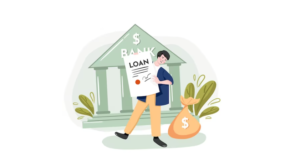Interest-Only Loans: When and How to Consider Them
Interest-Only Loan Considerations: Let’s clarify the idea of interest-only payments before we get into the things to consider. In a regular mortgage, the monthly amount you pay goes toward the capital and the interest. With an Interest-Only Loan Considerations on the other hand, you only have to pay the interest for a certain amount of time, usually the first 5 to 10 years. When compared to standard loans, this can mean lower monthly payments at first. Click here.
What’s Good About Loans With Only Interest (h3)
Few things are better than interest-only loans, which makes them a good choice for some people.
Lower first payments
The main appeal of interest-only loans is that the first monthly payments are lower. This can be helpful for people whose income changes often or who want to put money into other businesses.

“Dive into the world of Interest-Only Loan Considerations with our comprehensive guide. Learn when and how to leverage these financial tools for optimal results in your home financing strategy.
Possible Tax Advantages
Sometimes, you can write off the interest you pay on your debt. If you choose an interest-only loan, you may get more significant savings when you only pay interest.
Chance to put money to work (
Borrowers can invest the money they save when their monthly payments go down in other ways. People who are sure they can make gains higher than the loan’s interest rate may be most interested in this approach.
What’s Bad About Loans With Only Interest
There are some excellent things about interest-only loans but also some bad things.
Principal payments that were put off
You don’t pay down the capital amount during the interest-only term. Your loan amount stays the same, which could mean you have a more significant debt when you start making principal payments.
Risks in the market
Your home’s value may decrease if the real estate market is downturned. You might owe more on your home than it’s worth when it comes time to repay the debt.
Problems with Qualifying (h3) Interest-only loans aren’t open to everyone. Lenders may set tighter requirements for Qualifying, which could make it harder to get this kind of loan.
When to Think About Getting a Loan with Just Interest (h2)
Now that we’ve discussed the pros and cons, let’s talk about when an interest-only loan might be a good idea for you.
Ownership plans for a short time.
An interest-only loan can be a smart financial move if you only briefly plan to own the property. You can take advantage of the lower beginning payments without overthinking what will happen in the long run.
Property for investment
An interest-only loan can be valuable for people who want to invest in real estate. It gives you more control over your cash flow and lets you put money into multiple trading opportunities.

Navigating Home Financing: Interest-Only Loans Demystified – Know When and How to Consider Them
Income that changes
People who don’t have a steady source of income may find interest-only loans helpful during tough times. The smaller starting payments give you some wiggle room when money is tight, and you can raise the payments when things get back on track.
How to Judge a Loan With Only Interest (h2)
It’s essential to think carefully before choosing an interest-only loan. This step-by-step guide will help you make an intelligent choice.
Check to see how stable your finances are
Before choosing an interest-only loan, you should ensure your finances are stable. Think about how your income is going, how safe your job is, and how healthy your total financial balance is. This evaluation of yourself is very important for determining if the possible risks align with your financial goals.
Look at different interest rates.
Interest rates are a big part of how cost-effective an interest-only loan is. Look at rates from several companies and compare both set and adjustable rates. Ensure the interest rates are reasonable and fit your long-term financial plan.
Make plans to pay the principal.
Make a firm plan to repay the capital after the interest-only time. This could mean changing the budget, finding new ways to make money, or even selling the house if needed. Not having a clear plan will save you money in the long run.
Act of Interest-Only Loans: Balancing Act
When buying a home, interest-only loans are a one-of-a-kind partner. They give you financial freedom and strategic benefits, but they also come with risks. To make a wise economic choice, you must fully understand the details of interest-only loans.
FAQ: Interest-Only Loan Considerations
Interest-only loans are a unique choice in the world of mortgages that people don’t always understand. As you learn more about home loans, you’ll naturally have questions about these financial tools. Here is a complete FAQ-style guide that will help you understand interest-only loans better. It will answer common questions and show you when and how to use them for your financial journey.
When is it best to get a loan for just the interest?
Getting an interest-only loan might make sense if you want to lower your first monthly payments. It might work if you think you’ll have a short-term money problem or want to use it for other purchases shortly.
Some people choose interest-only loans. Why would they do that?
There are different reasons why people choose interest-only loans. Some of these are trying to be financially flexible, putting money into other businesses, or handling cash flow when income isn’t stable.
How can I tell if my loan only has interest?
Check your loan papers or talk to your lender to determine if your loan is interest-only. Interest-only loans generally have a set amount of time, usually the first part, when you only pay the interest and don’t make any payments on the principal.
What does an interest-only loan look like?
ARMs, which stand for adjustable-rate mortgages, are a popular type of interest-only loan. In this case, payments will be made on only the interest for the first five years. After that, payments will be made on the interest and the capital for the rest of the loan time.
What are the rules for interest-only loans?
Interest-only loans have a set payment schedule where the user only pays the interest for a specific time. After the interest-only phase ends, these loans usually switch to payments that cover both the capital and the interest.
Is “interest-only” a good choice?
Interest-only loans have perks, such as lower starting payments and possible tax benefits. But they also come with risks, such as capital payments being put off and market changes. It’s essential to look at your long-term goals and financial health to see if it’s a good choice.
How much does the capital of a loan with only interest cost?
During the interest-only term, the capital of an interest-only loan stays the same. People who take out loans only pay the interest that has been added to them. The capital amount remains the same until the interest-only phase ends.
What does “interest only for six months” mean?
A loan arrangement called “interest-only for six months” means that the borrower only makes payments on the interest part for six months. After this time, payments usually have both capital and interest parts.




Post Comment